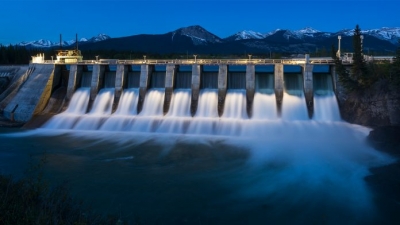
Hydroelectric energy, also called hydroelectric power or hydroelectricity, is a form of energy that harnesses the power of water in motion—such as water flowing over a waterfall—to generate electricity. People have used this force for millennia. Over two thousand years ago, people in Greece used flowing water to turn the wheel of their mill to ground wheat into flour.
Most hydroelectric power plants have a reservoir of water, a gate or valve to control how much water flows out of the reservoir, and an outlet or place where the water ends up after flowing downward. Water gains potential energy just before it spills over the top of a dam or flows down a hill. The potential energy is converted into kinetic energy as water flows downhill. The water can be used to turn the blades of a turbine to generate electricity, which is distributed to the power plant’s customers.
Hydroelectric energy is the most commonly-used renewable source of electricity. China is the largest producer of hydroelectricity. Other top producers of hydropower around the world include the United States, Brazil, Canada, India, and Russia. Approximately 71 percent of all of the renewable electricity generated on Earth is from hydropower.
The Three Gorges Dam in China, which holds back the Yangtze River, is the largest hydroelectric dam in the world, in terms of electricity production. The dam is 2,335 meters (7,660 feet) long and 185 meters (607 feet) tall, and has enough generators to produce 22,500 megawatts of power.
Credit : National Geographic Society
Picture Credit : Google




